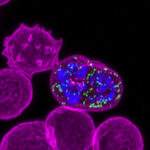Anton L, Cheng W, Haile MT, Dziekan JM, Cobb DW, Zhu X, Han L, Li E, Nair A, Lee CL, Wang H, Ke H, Zhang G, Doud EH, Cowman AF, Ho C-M. Integrated structural biology of the native malarial translation machinery and its inhibition by an antimalarial drug. Nature Structural & Molecular Biology. 2025;32(11):10.1038/s41594-025-01632-3
Kongsomboonvech AK, Scally SW, Le Guen Y, Valissery P, Salinas ND, Cowman AF, Tolia NH, Egan ES. CD44 cross-linking promotes Plasmodium falciparum invasion. 2025;:10.1101/2025.07.30.667750
Marapana D, Cobbold SA, Pasternak M, Shami GJ, Ralph SA, Lopaticki S, Yousef J, Vaibhav V, Dagley LF, Komander D, Cowman AF. Functional characterisation of components in two Plasmodium falciparum Cullin-RING-Ligase complexes. Scientific Reports. 2025;15(1):10.1038/s41598-025-05342-0
Hodder AN, Sleebs BE, Adams G, Rezazadeh S, Ngo A, Jarman K, Scally S, Czabotar P, Wang H, McCauley JA, Olsen DB, Cowman AF. Structure–activity analysis of imino‐pyrimidinone‐fused pyrrolidines aids the development of dual plasmepsin V and plasmepsin X inhibitors. The FEBS Journal. 2025;292(11):10.1111/febs.70038
2025;
Awalt JK, Ooi ZK, Ashton TD, Mansouri M, Calic PPS, Zhou Q, Vasanthan S, Lee S, Loi K, Jarman KE, Penington JS, Qiu D, Zhang X, Lehane AM, Mao EY, Gancheva MR, Wilson DW, Giannangelo C, MacRaild CA, Creek DJ, Yeo T, Sheth T, Fidock DA, Churchyard A, Baum J, Famodimu MT, Delves MJ, Kristan M, Stewart L, Sutherland CJ, Coyle R, Jagoe H, Lee MCS, Chowdury M, de Koning-Ward TF, Baud D, Brand S, Jackson PF, Cowman AF, Dans MG, Sleebs BE. Optimization and Characterization of N‑Acetamide Indoles as Antimalarials That Target PfATP4. Journal of Medicinal Chemistry. 2025;68(8):10.1021/acs.jmedchem.5c00614
Seager BA, Lim PS, Lai KH, Feufack-Donfack LB, Dass S, Xiao X, Jung NC, Abraham A, Grigg MJ, Anstey NM, William T, Sattabongkot J, Leis A, Longley RJ, Duraisingh MT, Popovici J, Wilson DW, Scally SW, Cowman AF. PTRAMP, CSS and Ripr form a conserved complex required for merozoite invasion of Plasmodium species into erythrocytes. 2025;:10.1101/2025.03.25.644866
Ashton TD, Calic PPS, Dans MG, Ooi ZK, Zhou Q, Loi K, Jarman KE, Palandri J, Qiu D, Lehane AM, Maity B, De N, Famodimu MT, Delves MJ, Mao EY, Gancheva MR, Wilson DW, Chowdury M, de Koning‐Ward TF, Baud D, Brand S, Jackson PF, Cowman AF, Sleebs BE. Lactam Truncation Yields a Dihydroquinazolinone Scaffold with Potent Antimalarial Activity that Targets PfATP4. ChemMedChem. 2024;19(24):10.1002/cmdc.202400549
Awalt JK, Su W, Nguyen W, Loi K, Jarman KE, Penington JS, Ramesh S, Fairhurst KJ, Yeo T, Park H, Uhlemann A-C, Maity BC, De N, Mukherjee P, Chakraborty A, Churchyard A, Famodimu MT, Delves MJ, Baum J, Mittal N, Winzeler EA, Papenfuss AT, Chowdury M, de Koning-Ward TF, Maier AG, van Dooren GG, Baud D, Brand S, Fidock DA, Jackson PF, Cowman AF, Dans MG, Sleebs BE. Exploration and characterization of the antimalarial activity of cyclopropyl carboxamides that target the mitochondrial protein, cytochrome b. European Journal of Medicinal Chemistry. 2024;280:10.1016/j.ejmech.2024.116921
Calic PPS, Ashton TD, Mansouri M, Loi K, Jarman KE, Qiu D, Lehane AM, Roy S, Rao GP, Maity B, Wittlin S, Crespo B, Gamo F-J, Deni I, Fidock DA, Chowdury M, de Koning-Ward TF, Cowman AF, Jackson PF, Baud D, Brand S, Laleu B, Sleebs BE. Optimization of pyrazolopyridine 4-carboxamides with potent antimalarial activity for which resistance is associated with the P. falciparum transporter ABCI3. European Journal of Medicinal Chemistry. 2024;276:10.1016/j.ejmech.2024.116677


